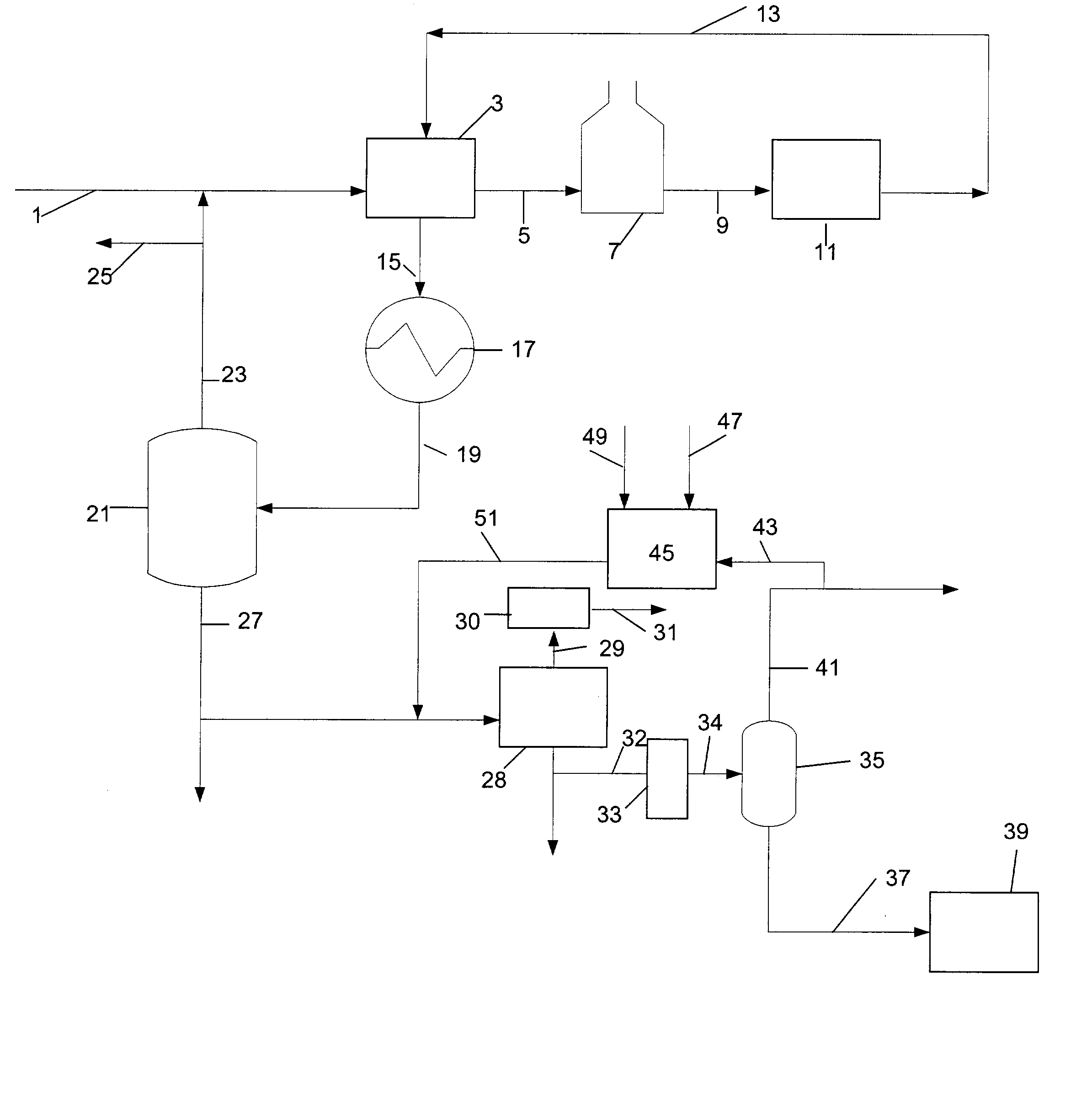Manufacture of xylenes using reformate
a technology of reformate and xylene, which is applied in the direction of physical/chemical process catalysts, hydrocarbon oil treatment products, bulk chemical production, etc., can solve the problems of significant cost increase of xylene production, bottleneck condition, and inability to extract the aromatics step, etc., to achieve the effect of high xylene conten
- Summary
- Abstract
- Description
- Claims
- Application Information
AI Technical Summary
Problems solved by technology
Method used
Image
Examples
example 1
[0081]A simulated naphtha reformate feed (naphtha reformate without hydrogen, C1–C5 hydrocarbons, and C8+ hydrocarbons) was subjected to methylation using a zeolite bound zeolite catalyst. The simulated feed had the composition given below in Table 1:
[0082]
TABLE 1ComponentWt. %C5−0.00n-C633.12i-C63.69n-C70.00i-C70.00Benzene15.85Toluene47.35PX0.00MX0.00OX0.00EB0.00C9+0.00Total100
[0083]The catalyst used for the test comprised 70 wt. % H-ZSM-5 core crystals (average particle size of 3.5 microns) having a silica to alumina mole ratio of 75:1 and 30 wt. % ZSM-5 binder crystals having a silica to mole ratio of approximately 900:1. The catalyst was prepared by first mixing the ZSM-5 core crystals with amorphous silica containing a trace amount of alumina and then extruding the mixture into a silica bound extrudate. Next, the silica binder of the extrudate was converted to the second zeolite by aging the aggregate at elevated temperatures in an aqueous solution containing a template and hyd...
example 2
[0089]A simulated light naphtha reformate feed was subjected to toluene methylation. The catalyst used in the test comprised 1 / 16 inch extrudates which contained 65 weight percent H-ZSM-5 and 35 weight percent silica binder. The catalyst had an alpha value of 330. The “alpha value” of a catalyst is an approximate indication of its catalytic cracking activity. The alpha test is described in U.S. Pat. No. 3,354,078 and in the Journal of Catalysis, Vol. 4, 522–529 (1965); Vol. 6, 278 (1966); and Vol. 61, 395 (1980), each incorporated herein by reference to that description.
[0090]The reformate feed used in the test had the composition given below:
[0091]
TABLE 4ComponentWt. %C5−0.00n-C618.58i-C615.04n-C74.30i-C75.37Benzene15.32Toluene41.38PX0.00MX0.00OX0.00EB0.00C9+0.00Total100
[0092]The test was carried out under the following conditions:
[0093]
TABLE 5ComponentWHSV ((h−1)1MeOH / :Toluene [molar]1H2:(MeOH + HCs) [molar]1Pressure (psig)64Temperature (° F.)700
[0094]The test was carried out by l...
example 3
[0097]A simulated light reformate, which would be formed by the dehydrocyclo-oligomerization of C2–C5 aliphatic hydrocarbons, was subjected to toluene methylation. The catalyst used in the test had an alpha value of approximately 22 and comprised 1 / 16 inch extrudates which contained 65 wt. % H-ZSM-23 having a silica to alumina mole ratio of 110:1 and 35 wt. % of alumina binder. The ZSM-23 was prepared according to U.S. Pat. No. 4,076,842.
[0098]The reformate feed used in the test had the composition given below:
[0099]
TABLE 7ComponentWt. %C5−0.00n-C60.00i-C60.00n-C735.00i-C75.00Benzene15.00Toluene45.00PX0.00MX0.00OX0.00EB0.00C9+0.00Total100
[0100]The test was carried out under the following conditions:
[0101]
TABLE 8ComponentWHSV (h−1)8MeOH / :Toluene [molar]1 / 3H2:(MeOH + HCs) [molar]2Pressure (psig)150Temperature (° F.)932
[0102]The test was carried out by loading the catalyst into a fixed bed reactor and heating the catalyst in flowing hydrogen to the reaction temperature. Next, the refor...
PUM
| Property | Measurement | Unit |
|---|---|---|
| pressure | aaaaa | aaaaa |
| temperature | aaaaa | aaaaa |
| molar ratio | aaaaa | aaaaa |
Abstract
Description
Claims
Application Information
 Login to View More
Login to View More - R&D
- Intellectual Property
- Life Sciences
- Materials
- Tech Scout
- Unparalleled Data Quality
- Higher Quality Content
- 60% Fewer Hallucinations
Browse by: Latest US Patents, China's latest patents, Technical Efficacy Thesaurus, Application Domain, Technology Topic, Popular Technical Reports.
© 2025 PatSnap. All rights reserved.Legal|Privacy policy|Modern Slavery Act Transparency Statement|Sitemap|About US| Contact US: help@patsnap.com



